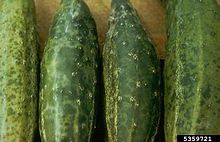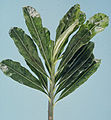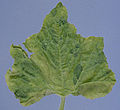- Cucumber mosaic virus
-
Cucumber mosaic virus (CMV) 
Fig. 1. A red-violet-stained hexagonal inclusion body of CMV. The blue-colored body below the virus inclusion is the nucleus of the cell. Virus classification Group: Group IV ((+)ssRNA) Family: Bromoviridae Genus: Cucumovirus Species: Cucumber mosaic virus Synonyms banana infectious chlorosis virus
coleus mosaic virus
cowpea banding mosaic virus
cowpea ringspot virus
cucumber virus 1
lily ringspot virus
pea top necrosis virus
peanut yellow mosaic virus
southern celery mosaic virus
soybean stunt virus
spinach blight virus
tomato fern leaf virus
pea western ringspot virusCucumber mosaic virus (CMV) is a plant pathogenic virus[1] in the family Bromoviridae[2]. It is the type member of the plant virus[3] genus, Cucumovirus[4]. This virus has a worldwide distribution and a very wide host range[5]. In fact it has the reputation of having the widest host range of any known plant virus (191 hosts in 40 families[6]). It can be transmitted from plant to plant both mechanically by sap and by aphids in a stylet-borne fashion. It can also be transmitted in seeds and by the parasitic weeds, Cuscuta sp. (dodder).
Contents
Hosts and Symptoms
In plant tissue this virus makes characteristic viral inclusion bodies which can be diagnostic. They are hexagonal in shape (Fig.1) and stain both in a protein stain and a nucleic acid stain[7]. The inclusions can also be rhomboidal (Fig. 2b), may appear hollow (Fig. 1) and can form larger aggregates (Fig. 3b). The inclusions are not uniformly distributed and can be found in epidermal (Figs. 1 and 2b), mesophyll (Fig. 3b), and stomata cells (Fig. 4b). These inclusions[8] are made up of virus particles.
This virus was first found in cucumbers (Cucumis sativus) showing mosaic symptoms in 1934[9], hence the name Cucumber mosaic. Since it was first recognized, it has been found to infect a great variety of other plants[10]. These include other vegetables such as squash, melons, peppers, beans[11], tomatoes, carrots, celery, lettuce, spinach[12] and beets, various weeds and many ornamentals and bedding plants. Symptoms seen with ths virus include leaf mosaic or mottling (Fig. 2a), yellowing (Fig. 3a), ringspots (Fig. 4a), stunting, and leaf[13], flower and fruit distortion.
CMV shows symptoms on leaves known as the “Shoestring” effect for most host species. This effect causes young leaves to appear narrow and the entire plant to be stunted.[14]Specifically CMV can cause cucumbers to turn pale and bumpy. The leaves of these plants turn mosaic and their rugosity is often changed, making leaves wrinkled and misshapened. Growth of these plants is usually stunted and produces few flowers. Often cucumber fruits are oddly shaped and appear gray. This appearance often leads to cucumbers being referred to as “white pickles.” Often infected cucumbers are bitter.
In celery, CMV can cause streaking and spotting and can be often confused with symptoms of the celery mosaic virus.
Symptoms of CMV in lettuce can be similar to those of Lettuce Mosaic Virus. Infected plants show symptoms of chlorosis, stunting and often do not properly head.
Some of the most important fruits and vegetables effected by CMV are peppers, bananas, tomatoes and cucurbits.[15]
CMV in peppers[disambiguation needed
 ] causes slightly different symptoms than the previously mentioned. Pepper plants often have severe foliar damage, shown as mosaic and necrotic rings. Often the peppers themselves are misshapen and contain chlorotic rings and spots.
] causes slightly different symptoms than the previously mentioned. Pepper plants often have severe foliar damage, shown as mosaic and necrotic rings. Often the peppers themselves are misshapen and contain chlorotic rings and spots.Tomato plants are usually stunted and have poorly shaped leaves, or “fernleaf”, when infected by CMV. Also certain strains of CMV can cause partial or total loss.
-
Fig. 2a. Symptoms of CMV on Desert rose (Adenium obesum)
-
Fig. 3a. Squash (Cucurbita pepo) infected with CMV
-
Fig. 3b. Inclusions (I) and the nucleus (N) of infected squash cells
-
Fig.4a. Symptoms in Commelina diffusa
-
Fig.4b. Inclusions in Commelina diffusa
Disease Cycle
CMV is mainly transmitted by aphids. It can also be spread mechanically by humans[16]. The virus is easily spread through cultivating and even touching healthy plants after touching infected plants. However CMV is less stable than viruses like TMV and therefore is not as easily spread by humans. The virus, as spread by aphids, has an acquisition period of five – ten seconds and an inoculation period of about a minute. However after two minutes the probability of inoculation largely decreases and within two hours is no longer able to be spread by that particular vector. This virus is non persistent and is stylet borne. CMV is carried by 60 - 80 different species of aphids and can also be transmitted by seed.
This virus can overwinter in perennial weeds, flowers and often crop plants by surviving in the roots. In the spring the virus grows with plant and emerges in the top leaves, where it is picked up by aphids and carried to other hosts. This virus causes a systemic infection.
The CMV genome consists of three single stranded RNAs, each of which is enclosed inside a coat protein. The translational process employed by this virus is referred to as subgenomic RNA. Once inside the plant the virus is able to inhibit the plants ability to signal for gene silencing in other tissues. This allows the CMV to invade further into the plant. This virus, like many, replicates in the cytoplasm. Movement through the plasmodesmata occurs for cell-to-cell transfers but the phloem is utilized for long distance movement within the plant.[17]
Environment
CMV is found in temperate areas around the world. This virus cannot live in extremely dry conditions. CMV is shown to develop symptoms more readily in temperatures between 79 and 89 degrees Fahrenheit.
Aphids are generally found in temperate regions and also generally infect in the direction of major winds.[18] Aphids generally infect later in the season and therefore preparing for them and planting early helps avoid these high populations.[19] However if the fall or spring is cool and wet the aphid population decreases and virus spread as decreases. Most disease will occur on the edges of fields in these conditions. But if the fall and/or spring is warm and less moist, aphids reproduce rapidly and subsequently spread the virus at a much higher rate. In these conditions crop infection rates are close to 100% and crops are usually a total loss[17]
Properties
CMV[20] is a linear positive-sense, single-stranded RNA virus. Its total genome size 8.621 kb and is broken into three parts. The largest part is 3.389 kb; the second largest is 3.035 kb; the third largest is 2.197 kb. The RNA is surrounded by a protein coat consisting of 32 copies of a single structural protein which form isometric particles[21].
Diagnosis
Correct diagnosis[22] of any plant disease requires some expertise. Plants suspected of a viral infection should be sent to a plant disease diagnostic laboratory where the presence or absence of the virus can be confirmed by serological ( ELISA ), genetic (PCR), or host range tests.
Management
No chemicals can cure a plant of this virus infection or of any other. Control measures for all plant viruses include prevention and eradication. (See Disease Management[23])
There is no perfect control for this virus. However, removing weeds and diseased plants from fields can reduce the chance of infections. Maintaining clean and sanitized tools, machines and hands can help.
The use of resistant varieties is another way some farmers control virus spread. Many use a “trap crop” method. In this method farmers plant resistant varieties around the perimeter of their fields and place the susceptible plants in the middle. Their intention is that the aphids carrying disease will first land on the resistant varieties and by the time they have eaten their way to the susceptible varieties they will no longer be carrying the virus. Crop growers also often spray mineral oil on their plants as the aphids do not like the mineral oil. Farmers have found that the use of chemicals and insecticides to control the aphids is not a practical or efficient way to control the disease spread. The use of insecticides is not very successful because the aphids become irritated and therefore jump from plant to plant in an attempt to avoid the insecticides, subsequently infecting healthy plants because the acquisition and inoculation time is very short.[14]
When planting in the same fields in successive years do not plant varieties of plants that are susceptible to CMV. Since CMV can overwinter in perennial plants and weeds the virus can enter the roots and present itself at the top of the plant in the springtime where it can be retransmitted by aphids.[15]
Importance
CMV has one of the widest host ranges of plant viruses. It is found worldwide, is very easily spread and causes severe damage to the host. CMV infects 191 host species in 40 families by more than 60 different aphid species and other vectors. There is often a loss of 10-20% of yield and even if harvested, crops are commonly found in poor condition. CMV can infect over 1200 plant species including important vegetable crops and ornamentals.[17]
References
- ^ Description of Plant Viruses:What are viruses?
- ^ Description of Plant Viruses: Bromovirideae
- ^ About Plant Viruses
- ^ Description of Plant Viruses:Cucumovirus
- ^ Plant Viruses Online:Cucumber mosaic host range
- ^ Crop Knowledge Master: Cucumber Mosaic Virus
- ^ Materials and Methods for the Detection of Viral Inclusions
- ^ Inclusions of Cucumber mosaic virus
- ^ Price, W.C. 1934. Phytopathology 24: 743.
- ^ Douine, L., Quiot, J.B., Marchoux, G. and Archange, P. 1979. Annls. Phytopath. 11: 439
- ^ Vegetable MD Online: Bean – Cucumber mosaic Cucumovirus
- ^ Vegetable MD Online: Virus Diseases of Leafy Vegetables and Celery
- ^ Vegetable MD Online: Important New York Vegetable Diseases
- ^ a b http://www.avrdc.org/pdf/tomato/CMV.pdf
- ^ a b http://www.extento.hawaii.edu/kbase/crop/type/cucvir.htm
- ^ http://www.weekendgardener.net/plant-diseases/cucumber-mosaic-virus-070707.htm
- ^ a b c http://www.apsnet.org/edcenter/intropp/lessons/viruses/Pages/Cucumbermosaic.aspx
- ^ http://www.hort.uconn.edu/ipm/veg/htms/pepvrus.htm
- ^ http://www.aces.edu/pubs/docs/A/ANR-0868/ANR-0868.pdf
- ^ ICTVd Descriptions:Cucumber mosaic virus
- ^ ICTVdB - Picture Gallery:Images of CMV
- ^ How do you diagnose a virus infection in a plant?
- ^ Pest Alert: Cucumber mosaic virus
Other on-line Links about CMV for growers and gardeners
1. Texas Plant Disease Handbook: Cucumber Mosaic
2. Weekend Gardener: Cucumber mosaic virus
3. Ohio Floriculture: Cucumber mosiac virus
External links
- ICTVdB - The Universal Virus Database: Cucumber mosaic virus
- Family Groups - The Baltimore Method
- Plant Viruses Online – VIDE Database
- Descriptions of Plant Viruses
- Weekendgardner Monthly Web Magazine: Cucumber Mosaic Virus
- Crop Knowledge Master: Cucumber Mosaic Virus
- AVRDC - The World Vegetable Center Fact Sheet: Cucumber Mosaic Virus
- University of Illinois Extension - Report on Plant Disease: Mosaic Diseases of Cucurbits
- APSnet: Cucumber Mosaic Virus
- Alabama Cooperative Extension System - Alabama A&M and Auburn Universities Plant Disease Notes: Cucumber Mosaic Virus
- Florida Tomato Scouting Guide: Cucumber Mosaic Virus
- HYPP Pathology: Cucumber Mosaic Virus
- ICTVdB Virus Descriptions: Cucumber Mosaic Virus
Categories:- Viruses
- Viral plant pathogens and diseases
-
Wikimedia Foundation. 2010.








